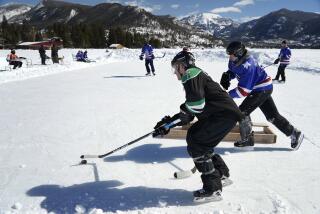Perhaps Alaska Idea Should Be Put on Ice
- Share via
Environmentalists in Alaska are, to say the least, cool to the idea of harvesting glacier ice and selling it to tourists and others.
Private businesses, it seems, are collecting chunks of glacier ice to sell as curios to foreigners, especially Japanese, and as the basis for products such as vodka and shampoo. There are also those hoping to market it to people concerned about the purity of their drinking water.
The Alaska Department of Natural Resources has approved 11 glacier ice-harvesting permits that allow collecting up to 5,699 tons of ice a week in Prince William Sound and the Gulf of Alaska.
However, the U.S. National Park Service and environmental groups, concerned that the infant industry will grow uncontrollably, say the entrepreneurs are carving away the Alaskan wilderness for the sake of profit.
“To me, there’s not an aspect of it that isn’t wasteful,” said Peter Fitzmaurice, chief ranger for Kenai Fjords National Park. “You can make ice cubes in your freezer. It’s symbolic of what I see as a bad direction in our development.”
Added Cliff Eames, issues director for the Alaska Center for the Environment: “What is the essential social and economic need to harvest glacier ice? It’s not a very great one.”
But Gary Prokosch, a water resources manager for the state’s Department of Natural Resources, said the permits contain enough restrictions to prevent harm to wildlife or to Alaska’s natural beauty, which attracts increasing numbers of tourists every year.
Prokosch said environmentalists’ calls for sweeping regulation of the glacier-ice business are unwarranted.
“It’s a little early for an overall management plan for an industry that we don’t even know is going anyplace,” he said.
Quick Fact: Just in case you were wondering, a ton of ice would make a cube measuring about 10 feet on each side.
Hungarian Connection: Hungary, which has a population of about 10 million, attracted 14.5 million tourists in 1989, including a 27% increase over 1988 in those from the United States.
Perhaps not coincidentally, Malev Hungarian Airlines has opened a sales and reservations office at 1888 Century Park East, Century City. To facilitate travel to Hungary, the airline has entered a joint venture agreement with PanAm for direct flights from New York to Budapest.
Los Angeles has the third-largest Hungarian population in the United States after New York and Chicago.
Down Mexico Way: The number of tourists visiting Mexico increased by 10.6% in 1989, and visitors spent an average of 4.5% more than in the previous year, according to a study by the National Bank of Mexico.
The report said that 6.24 million tourists visited Mexico last year, the largest number coming from the United States.
Quick Fact: The U.S. travel and tourism industry generates more revenue from foreign dollars than that generated from exports of automobiles, agricultural goods or chemical products.
The Lone Horn State?: No, the Texas rhinos are not another sports team. They’re real, as visitors to the Ft. Worth Zoo soon will be able to discover.
Two 8-month-old one-horned rhinoceroses were given to the zoo recently by King Birendra of Nepal. One-horned rhinos, an endangered species, are found only in Nepal and the Indian state of Assam. Nepal has slightly more than 300 in Nepal and Assam about 1,000.
Three years ago King Birendra presented four rhino calves to President Reagan. The rhinos have been kept at zoos in Washington and San Francisco. Now Texas has a pair of its own.
Checking In: American Express traveler’s checks will be available this summer in Czechoslovakia through Cedok, the national travel company. Previously, the checks were sold at a few banks in Eastern Europe.
Icy Stillness: So far most of the dense, blue-green glacier ice harvested in Alaska has been sold in Japan, where the craze began accidentally with a marketing display set up in Tokyo in 1987 to promote bottled Alaska water.
Those attending the exhibit were intrigued not by the water but by the chunks of sample ice floating in the water glasses and by the cracking sound the ice made as it melted.
The Japanese called the sound “the whisper of the ages.”
Tunnel Vision: A report prepared for the Economist of London says that “the Channel Tunnel will be the most significant travel development of the 1990s not only in terms of speed of travel but also in terms of the likely cultural impact.”
Gee, and we always thought it was the Berlin Wall coming down.
More to Read
Sign up for Essential California
The most important California stories and recommendations in your inbox every morning.
You may occasionally receive promotional content from the Los Angeles Times.













